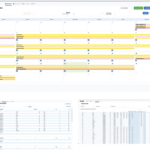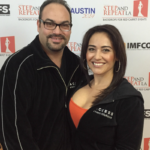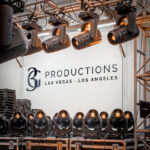Jerry Krulewicz has wired the last four decades of the live event industry. From his days as a teen working with big bands to Broadway, through Saturday Night Live to a political summit at the threshold of Soviet Union's fall to the Olympics and houses of worship, he's stared down every technical challenge with one simple approach: There must be a better way. But it's not just the new things he and his team at Wireworks keep coming up with – his old things are still pretty cool. In the 1970s, Krulewicz experienced and researched a number of different connector combos and came up with what still is today the audio Multipin System for Broadway. "It was the end of super long cables, end of cables permanently attached to boxes," Krulewicz explains. In its place was an easy-to-use mix and match system that provided superior audio. "Everybody went, ‘oh! That's perfect!' and it was immediately adopted by all of Broadway." Asked if he every imagined it being so popular, let alone still being in use nearly 40 years later, he says, "It's a little weird – I mean, it's still the same part number! We did 10 Broadway shows this season and they are still ordering parts for this product. It's kind of amazing."
Richard Chilvers, senior product specialist, stresses that they don't just take orders and fill them, but think them through first. "We'll get a request for a cable assembling at x number of feet, and then after examining it carefully, we'll have to gently remind them that there is a length issue," Chilvers says. "Engineers and designers have so many parts of the system to handle, but this is what we do. We're used as a resource. We can't blindly supply what we've been asked for – it would be irresponsible to do so."
Chilvers has been with Wireworks for 11 years, and prior to that, had his own cable and video wiring company that was both a customer and vendor for Wireworks. Prior to that, he worked for various U.K. audio companies here in the States as a liaison.
"We're in a constant stage of innovation," Chilvers says. "And all these innovations come from Jerry."
The Need for Great Results
Gerald "Jerry" Krulewicz grew up in New Jersey where, by the time he was in high school, he was deeply involved in technical theater. Before he was even out of school, he worked at a nightclub called The Flagship where the stars of the time frequently performed. This included the big bands of Count Basie and Duke Ellington, along with comedians like Jackie Mason and Flip Wilson.
"It was there I got the idea of balancing, and realized that the technician doesn't need to know how something works, he or she just needs it to happen," he explains. "They just want great results." He has fond memories from this period. He and Wilson did Wilson's famous "Geraldine" character to each other. When Paul Anka came through, he announced he had just written a song for Frank Sinatra that he wanted to perform, and then launched into "My Way."
But there were always technical issues. "For anybody who lived through that era, the challenge was how to devise the electrical correctly, and the Flagship was certainly a challenge, partially because it was huge. They served 1,000 dinners twice a night."
The club would, alas, not last, closing after just a year. But the young Krulewicz merely went down the street to the Paper Mill Playhouse, a respected regional theater that is still thriving today. There he "got thrown into another realm, real theater." He was learned a lot working with early productions of The Prime of Miss Jean Brody and Cabaret.
Meanwhile, he was studying technical theater at New York University. "Everybody, including the teachers, were working in the industry – working on a Broadway show, doing scene construction somewhere else, working with someone in the film department who was shooting a scene from a film that night," he says. He was also involved with the Fillmore East, which just opened up. "We were going over there and putting projections up on the wall for the shows there."
During this period, he got involved in the first-ever multimedia rock ‘n' roll show. A novel slant on Shakespeare's Twelfth Night featured a dozen carousel projectors. "It was a challenge getting that whole part of the show under control." He did it by building a control panel that could be played like a keyboard to execute cues, with buttons for all the individual projectors brought cohesively together. "They just had a piece of wood with all these projectors hooked up – it was like the dark ages!" He succeeded so well he was invited to go on the road with the show in 1969.
The rigors of the road were unveiled to the young man immediately. "Now, not only am I in charge of the projection, but I'm doing it in a different theater working with different people every night," he says. "It's not like you have anything under control yourself. My thought was, ‘how can I make my life easier?'" For every nice theater in a Vancouver where they played for a week, there would be more one-nighters in modest spaces with no orchestra pit and sub-standard electrical. "I'd have all these power needs and I'd be working with the local carpenter, always adapting for the situation. That's where by necessity I started getting the cabling for all the lighting organized." He laughs and admits part of his desire to keep things organized was motivated by selfish reasons: "The faster you put a show together, the more time you had off! You'd come to a new town and if it was disaster, you'd be like, ‘wow, we'll be setting up for eight hours and I'll get no dinner!'"
They did 200 cities across the country, and highlights included when one of the lead actresses was ill, and the understudy proved not good enough, the producers sent a young Priscilla Lopez down to fill in. Krulewicz would see her again a few years later as one of the stars of A Chorus Line.
Broadway and SNL
He moved up to the big league when he worked on the original Broadway road production of Promises, Promises, produced by David Merrick in 1968. "A lot of attention had to be paid to that show because with [Merrick], everything had to be right all the time." From there he worked on the original Applause. As hard as it is to believe, even on these big complicated shows, "there weren't really sound departments," Krulewicz says. The electricians were responsible for setting up mics and speakers and, at times, even sitting behind the audio board.
By 1974, he was an assistant to Jack Mann, who would be the first person to have the title "sound designer." Days working in the shop creating a special cable for this and that with Mann taught him a lot. "He was my mentor, and he understood what the people were looking for," he says. "He gave me a good perspective on how to deal with being in a high profile circumstance and getting it done so that no one says a word about your job. That's what you want – if they say nothing about your job, that's really great!"
Mann noticed Krulewicz had a real talent and encouraged him to start Wireworks with Larry Williams, who today is the company's CFO. In its first year, Wireworks would introduce the first full line of commercially-available multi-channel audio cables, and in 1976 introduced the first pocket-sized hand-held microphone cable tester, the TE-1.
Meanwhile, Krulewicz was always working on shows that were increasingly challenging. He was power consultant on Alvin Ailey's Eastern European tour where he "was trying to do things with electricity that wasn't stable enough to run a clock."
Also in 1976, Krulewicz became part of television history working on the second season of Saturday Night Live, building "anything that's electric." The show always had a reputation for last-minute changes to a scene, and even replacing one at the last minute. That madness engulfed the crew, too. "They wouldn't give us any direction all week, and suddenly, on Saturday afternoon we'd start getting these faxes to do this, build that, produce this. We had to do it quickly and get it over to load it into 30 Rock [where the show was filmed]. A lot of times I would make things I didn't even know what they were going to do with it. It was a wild time."
Oh, and 30 Rock didn't have a freight elevator. So not only did he have to build that set for the "Shoot for the Stars" game show parody quickly, but it had to be able to fit – or at least be broken down – and squeezed into a standard elevator, then quickly re-assembled on the set.
His invisible hand was behind many great sketches. There was the Christmas sketch called "Consumer Probe" with Dan Aykroyd pedaling questionable children's toys, including "Teddy Chainsaw Bear," which he built and operated. For another hilarious sketch called "Plug" featuring Steve Martin, they needed the cord to a life support machine hooked up to John Belushi that under any circumstance could not be unplugged. "I was told a character was going to pretend to trip over the cord, and then pull on it, but no matter what, the wire can't come out of the wall. So I constructed this pulley system that made the cord snap back into wall." He didn't realize how funny he had made it until he saw it on TV later.
Red State/Blue State
He was also part of history of a very different, much more sober sort: The presidential election of 1976. ABC anchor David Brinkley had an idea for a massive U.S. map, 40 feet wide, which featured the states. The idea was as the election night went on, the states, initially white, would change color to blue or red as they went Republican or Democrat. "No one had thought of this before, but here was Brinkley and his sidekick little Tommy Brokaw asking for it. But on realizing we'd need 9,000 lights, I said this thing is going to melt." So they cut windows behind it and put full sized air conditioning window units to keep the country from melting down.
But to show impartiality, the blue and the red states had to be the exact same brightness. He clustered white, blue, and red lights together, and considerable math was used. "We did this sample of two blues at 7-1/2 watts, one red at 7 watts, and a white at 5 watts, and put it on the camera," he explains. "But the red was too bright." Further tinkering brought it all together until Brinkley came up and says, "That's great! But what happens to people who still have black and white televisions?" "I could have killed somebody," Krulewicz laughs. So they had to change the entire configuration so it worked for all televisions, appearing as distinctive shades of gray for those without color sets.
(Interesting to note that states going for Republican Gerald Ford were noted by the color blue, and Democrat Jimmy Carter's states were red…it would be switched for the next election and every one after.)
Still something else worried Krulewicz: Looking at it before airtime, he noticed that if both Texas and California went blue, they'd be "big trouble" – and not politically. The size of the states would overwhelm the whole board. But he was assured that they both wouldn't go Republican (California went for Ford and Texas went for Carter).
Meanwhile, Wireworks continued to flourish with a continuous flow of simple but ingenious ideas. In 1978 they were the first company to sell a complete line of colored microphone cables. They also manufactured a line of disconnectable audio multicables using multipin connectors.
The next year their mix and match multicables hit the market, which comprised of the MultiBox, MultiTrunk, and MultiTail units. These are still heavily in use today.
Reagan and Gorbachev
Around this time, Krulewicz would attend an AES show where Sony executives were ushering audio people up into a suite at the Waldorf Hotel to show them a little piece of technology that would change their world: The CD. "It caused a panic," he recalls. "It made it possible that a person could hear a Broadway show better at home then in the theater. What that did was leave a challenge for the theater people to vastly improve audio systems in theaters, and pro audio just exploded."
Wireworks met the needs, and their client roster bloomed. This included Radio City Music Hall, where they participated in their 1979 renovation. The following year they specified and installed a system into the mega church's mega church, Crystal Cathedral in Garden Grove, CA. Wireworks multipin systems were also part of Walt Disney World's EPCOT Center when it was built in 1982.
In 1985, Wireworks System 502 combined audio and video multipin detachable cabling systems for the historic Geneva Summit between president Ronald Reagan and Soviet Union leader Mikhail Gorbachev. "NBC came to us and said, "We're covering this summit, and we need to build a portable studio," Krulewicz recalls. The requirements were state-of-the-art audio/video equipment workable in a module studio that could break down and be reconfigured in any way they needed. What came from that was their System 502. "It was the first time a set of video and audio connectors were combined."
That year they were also called on for the Carnegie Hall renovation, and three years later were an official supplier to the Winter Olympics in Calgary, Alberta. When the technological enveloping-pushing original production of Phantom of the Opera on Broadway debuted, it was Wireworks who manufactured and supplied the motion control cables assembling.
They have also always provided some DMX cables and lighting controls, though visually they are most prominent in the audio/video cabling challenge. "What has happened is, as people are working on Broadway shows, road shows, and doing fixed installation, cabling has gotten 10 times more complicated," he says. Live event professionals are asked to run analog audio, digital audio, some fiber, video, data, and more in a single Multipin Connector – the AV2000, first introduced in 1998, and still in heavy demand.
In 2000, the company introduced the flexible and award-winning WireLUX line of audio cables.
Cable-sharing Technology
The team at Wireworks has hardly rested on their laurels. Most recently they've produced the award-winning MCat524 MultiChannel Cat 5e Cabling. "Again, this was a situation of you looking at what is happening, and you just say, ‘There's got to be a better way.'" It provides six Cat 5e channels supporting 10000BASE-T in a single road-worthy trunk cable, and the cable-sharing technology allows technicians to adjust in different situations when running different protocols. He laughs and says, prior to this, it was as if "we were back in the dark ages" and it was "1971, and people were taping mic cables together again.
"By combining audio, video, data and control signal cables in just one single connector, it is a good solution for educational situations to arenas – it's currently being used in the U.S. Senate Office Building," Krulewicz adds. "It's a really flexible system, and we like seeing how people come up with different ideas on how to use it – like in production trucks. That's exciting."
Krulewicz was also one of the first to see that the world of digital was taking over sound, and that meant cables need to be different. As fewer XLR lines are run, they've responded with their line of digital connections.
More Than Just Cables
Success has its challenges though: "What we've seen is, people remember companies and how they were first introduced," he says. "We do tons of custom panels for shows, concert tours, houses of worship, but people who started years ago buying cable from us think that's all we do, no matter how many times we tell them we do panels."
Looking forward, he sees the technical side of the industry continually being challenged. "What you're trying to do is entertain the public, and that means you're going need to show the audience something they haven't seen before – better, different, unique. Because of that artistic drive, our job is to make meeting artistic ambitions as simple as possible for the designer. From a cable point of view, all these complex pieces of equipment have to interconnect, and it better work. It has to meet signal requirement and be reliable, working over and over again. The last thing we ever want to see is a show stop because a cable doesn't work."


